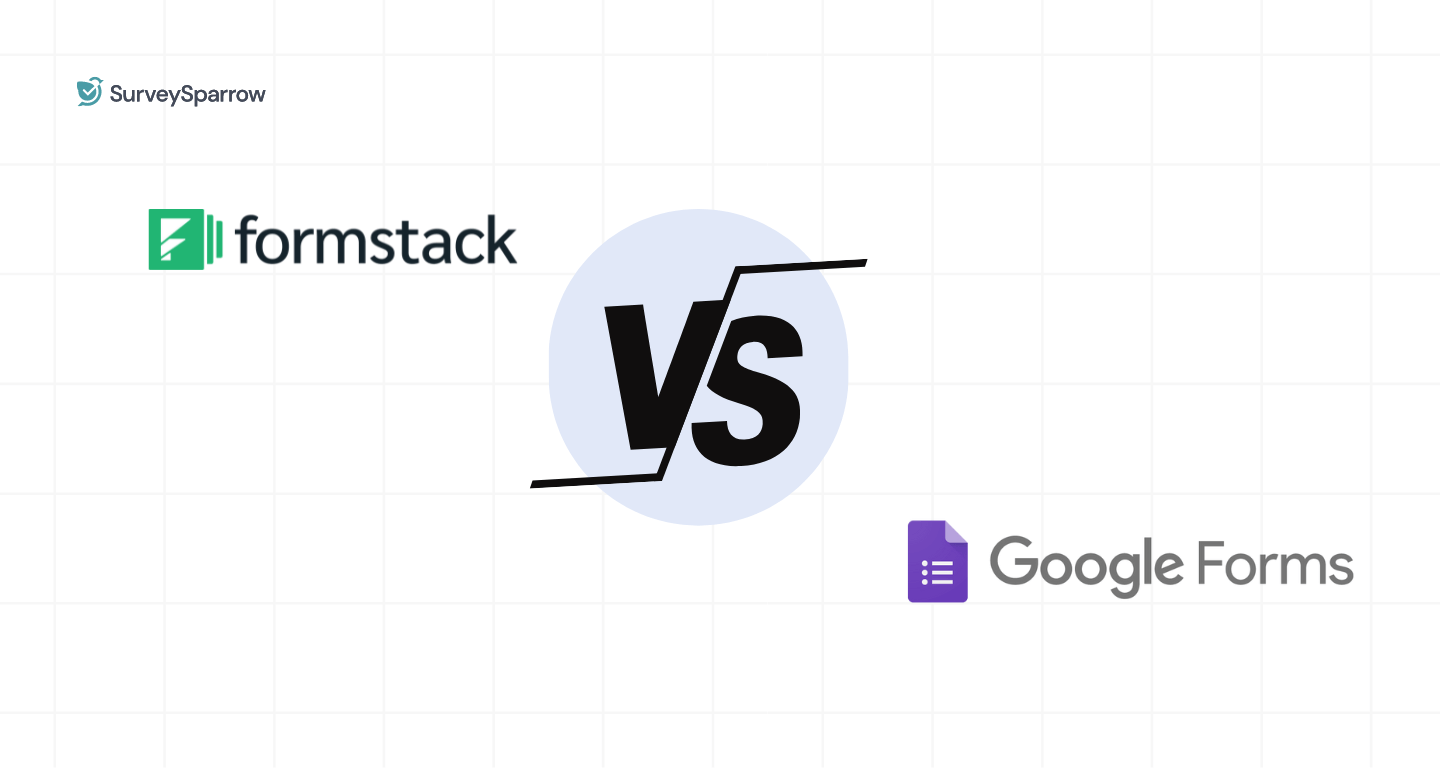Survey & Feedback
What is Interval Scale: A Comprehensive Guide
Article written by Nishanth P K
Sr. Growth Marketer at SurveySparrow.
7 min read
19 September 2025

When it comes to making smart decisions based on data, knowing how to measure information is crucial. One of the most useful methods for this is the interval scale measurement. It's a quantitative approach to measure data that not only ranks values but also shows the exact difference between them.
Whether you’re measuring customer satisfaction, employee performance, or any other survey where the gaps between numbers matter, understanding the interval scale can help you get clear and reliable insights. It enhances data quality and respondent engagement, making them an essential tool for accurate and reliable data collection.
However, there are some things you should know about interval scale. And that's what I'm going to do in this blog.
From helping you understand what it is to how it works, you will get everything from this blog. By the end, you’ll see how the right platform can make your data collection smoother and more effective.
Let’s get started!
What Is Interval Scale?
An interval scale is a way to measure things where you can tell how much more one thing is compared to another.
For example, think about temperature in Celsius. During a survey you found that it's 10 degrees at one place and 20 at another. Here, you know that 20 degrees is 10 degrees warmer than 10 degrees.
The thing is that there won't be any true starting point. Like in the case of the example, 0 degrees Celsius doesn't mean there’s no temperature. It's still a low one, that's it.
Note: In terms of level of measurement, interval scale is right there with ordinal and nominal scales.
I have added another example in the following section to give you a clear idea of the interval scale.
Example Of Interval Scale
Imagine you are conducting a survey to understand customer satisfaction for a product. You decide to use an interval scale to get more precise feedback.
The survey question would go something like the following.
"On a scale of 1 to 10, how satisfied are you with our product?"
- 1 = Very Dissatisfied
- 2 = Dissatisfied
- 3 = Somewhat Dissatisfied
- 4 = Neutral
- 5 = Somewhat Satisfied
- 6 = Satisfied
- 7 = Very Satisfied
- 8 = Extremely Satisfied
- 9 = Almost Perfect
- 10 = Perfect
Why Is This is an Interval Scale?
Here are two main reasons why this is an ideal example of interval scale.
1. Equal Intervals
The difference between each number is the same.
For example, the difference in customer satisfaction between 4 and 5 is the same as between 8 and 9. This allows you to say that someone who rates their satisfaction as 8 feels equally better than someone who rates it as 7, just as someone who rates it as 5 feels better than someone who rates it as 4.
2. No True Zero Point
In this case, a rating of 0 does not exist. A score of 1 indicates "very dissatisfied," but it doesn’t mean "no satisfaction" in an absolute sense.
Another real-world example of an interval scale is IQ scores.
The average IQ score is set at 100
Standard deviations are typically 15 points
The difference between an IQ of 100 and 115 is the same as the difference between 115 and 130
An IQ of 0 doesn't represent "no intelligence" (it's not a possible score)
Hope these examples of interval scale were helpful to give you a clear idea. Now, let's look at the characteristics of interval scale.
Characteristics of Interval Scale
Equal interval and no true zero point are two main characteristics of interval scale. Since we have already discussed them, let’s look at the remaining key characteristics.
- Interval data can be discrete and continuous. That is, it can be discrete with whole numbers like 8 degrees, 5 years, 6 months, etc., or continuous with fractional numbers like 10.9 degrees or 3.5 years.
- Unlike nominal scale or ordinal scale, interval scale is quantitative in nature. Therefore, it can quantify the difference between values and make sense of it.
This scale is preferred in statistics because of its quantifiable nature. It can be really helpful in calculating important statistical measures such as mean and median.

Want to Make the Most of Interval-Scale Questions in Your Surveys?
A personalized walkthrough by our experts. No strings attached!
Common Examples of Interval Scale Questions
Interval scale questions are a vital component of survey design. Why? Because it allows researchers to capture nuanced opinions and feelings quantitatively.
These questions provide ordered responses with equal intervals between points, which facilitates sophisticated statistical analysis.
1. Likert Scale

The Likert scale is widely used to gauge attitudes or feelings about a specific statement. Respondents indicate their level of agreement on a scale, typically from 1 to 5 or 1 to 7.
Example Statement: "I am satisfied with the service provided."
Response Options:
- 1: Strongly Disagree
- 2: Disagree
- 3: Neutral
- 4: Agree
- 5: Strongly Agree
This format allows researchers to quantify sentiments and perform statistical analyses on the collected data.
2. Net Promoter Score (NPS)

NPS measures customer loyalty by asking respondents how likely they are to recommend a product or service on a scale from 0 to 10:
Response Interpretation:
- Scores from 0-6 are considered "detractors."
- Scores of 7-8 are "passives."
- Scores of 9-10 are "promoters."
This method provides valuable insights into customer satisfaction and loyalty trends.
3. Bipolar Matrix Questions

These questions assess sentiments across two opposing attributes using an interval scale. For example, respondents might rate their feelings about a product's quality versus its price:
Example Attributes: Quality vs. Price
Response Options:
- Poor Quality / Low Price
- Fair Quality / Fair Price
- Good Quality / High Price
This format allows for a nuanced understanding of how different attributes are perceived relative to each other.
Related Read: Learn more about matrix survey questions.
How SurveySparrow Simplifies Interval Scale Surveys?
Creating surveys using interval scales doesn't need to be complicated. SurveySparrow offers an easy-to-use platform where you can design and share interval scale questions in just a few clicks.
One such feature is its AI-powered survey builder. Just add in the prompt, and the tool will create a brand new survey from scratch in seconds.

You can get up to 10 survey questions, including one NPS, CSAT, and Likert Scale questions. There will be a default design for AI surveys, which you can change or customize to your needs. You can get access to this feature with the free version of the tool.
If you want to create manually, you can do that as well. The tool is very easy to use and understand. Other key features include
- Omni channel survey distribution (including WhatsApp)
- Multilingual surveys (over 130+ languages)
- Advanced AI-powered data analysis
- Conversational surveys (better survey response rate)
Intrigued yet? Try SurveySparrow for free and see how easy it is to gather and analyze data.
14-day free trial • Cancel Anytime • No Credit Card Required • No Strings Attached

Create engaging surveys that people actually complete. Try SurveySparrow now!
Nishanth P K
Growth Marketer with flair for experience management. Aspiring author.
Frequently Asked Questions (FAQs)
An interval scale has meaningful differences between values but no true zero (e.g., temperature). A ratio scale has both meaningful differences and a true zero point (e.g., weight, height).
An interval scale provides ordered data with equal intervals (e.g., temperature). Whereas a nominal scale categorizes data without order or value (e.g., gender, hair color).
Some real-world applications of interval scale are temperature (Celsius/Fahrenheit), customer satisfaction ratings (1-10), IQ scores, and calendar years.
Related Articles

Survey & Feedback
Formstack vs Google Forms: A Detailed Comparison
14 MINUTES
5 March 2024

Survey & Feedback
What is Survey Fatigue and how to combat it?
13 MINUTES
5 August 2019

Survey & Feedback
What are On Site Surveys? Meaning, Benefits and How to Use it
8 MINUTES
28 March 2024

Survey & Feedback
What Is Desk Research : Definition, Methods, and Examples
12 MINUTES
24 December 2021
